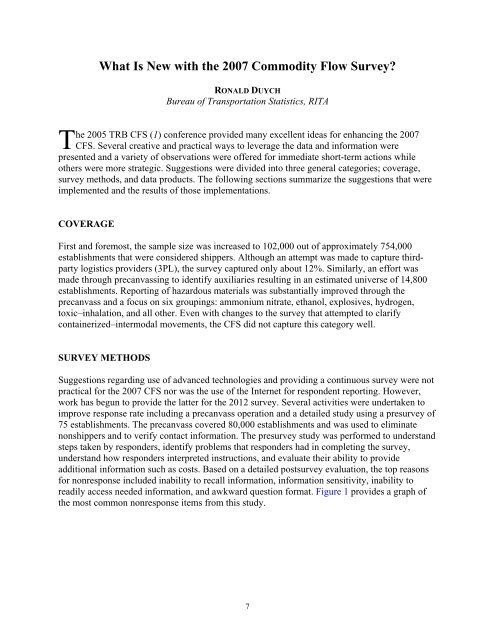E-C158 Cover1 - Center for Transportation Analysis - Oak Ridge ...
E-C158 Cover1 - Center for Transportation Analysis - Oak Ridge ...
E-C158 Cover1 - Center for Transportation Analysis - Oak Ridge ...
You also want an ePaper? Increase the reach of your titles
YUMPU automatically turns print PDFs into web optimized ePapers that Google loves.
T<br />
What Is New with the 2007 Commodity Flow Survey?<br />
RONALD DUYCH<br />
Bureau of <strong>Transportation</strong> Statistics, RITA<br />
he 2005 TRB CFS (1) conference provided many excellent ideas <strong>for</strong> enhancing the 2007<br />
CFS. Several creative and practical ways to leverage the data and in<strong>for</strong>mation were<br />
presented and a variety of observations were offered <strong>for</strong> immediate short-term actions while<br />
others were more strategic. Suggestions were divided into three general categories; coverage,<br />
survey methods, and data products. The following sections summarize the suggestions that were<br />
implemented and the results of those implementations.<br />
COVERAGE<br />
First and <strong>for</strong>emost, the sample size was increased to 102,000 out of approximately 754,000<br />
establishments that were considered shippers. Although an attempt was made to capture thirdparty<br />
logistics providers (3PL), the survey captured only about 12%. Similarly, an ef<strong>for</strong>t was<br />
made through precanvassing to identify auxiliaries resulting in an estimated universe of 14,800<br />
establishments. Reporting of hazardous materials was substantially improved through the<br />
precanvass and a focus on six groupings: ammonium nitrate, ethanol, explosives, hydrogen,<br />
toxic–inhalation, and all other. Even with changes to the survey that attempted to clarify<br />
containerized–intermodal movements, the CFS did not capture this category well.<br />
SURVEY METHODS<br />
Suggestions regarding use of advanced technologies and providing a continuous survey were not<br />
practical <strong>for</strong> the 2007 CFS nor was the use of the Internet <strong>for</strong> respondent reporting. However,<br />
work has begun to provide the latter <strong>for</strong> the 2012 survey. Several activities were undertaken to<br />
improve response rate including a precanvass operation and a detailed study using a presurvey of<br />
75 establishments. The precanvass covered 80,000 establishments and was used to eliminate<br />
nonshippers and to verify contact in<strong>for</strong>mation. The presurvey study was per<strong>for</strong>med to understand<br />
steps taken by responders, identify problems that responders had in completing the survey,<br />
understand how responders interpreted instructions, and evaluate their ability to provide<br />
additional in<strong>for</strong>mation such as costs. Based on a detailed postsurvey evaluation, the top reasons<br />
<strong>for</strong> nonresponse included inability to recall in<strong>for</strong>mation, in<strong>for</strong>mation sensitivity, inability to<br />
readily access needed in<strong>for</strong>mation, and awkward question <strong>for</strong>mat. Figure 1 provides a graph of<br />
the most common nonresponse items from this study.<br />
7

















